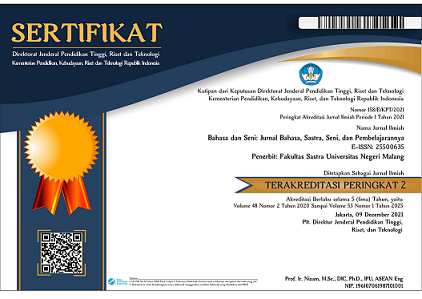KAJIAN PRAGMATIK PADA KOSAKATA DAN FONETIS BAHASA PENDERITA AFASIA GLOBAL
Abstract
Aphasia is a language disorder caused by brain injury. This study aimed at describing how the pragmatic process and forms on words and language phonemes of those suffering from global aphasia. The study is qualitative research using case study approach. The primary data on this study were collected by purposive sampling whose subject was a global aphasia sufferer who had obtained language rehabilitation during one-year period. The secondary data were taken by using in-depth interview with the family, therapist, and subject's neighborhood. The data were analyzed by comparing the in-depth interview result and the field notes of research. The result showed that the individual with global aphasia still had pragmatic abilities, although s/he could produce meaningless words and sounds. In addition, the individual with global aphasia used gesture and intonation to help convey the idea of her/his utterence. The gestures and intonations performed by the individual with global aphasia were nodding and shaking head, and moving hands; while the forms of intonation changes were sudden change in intonation, imitating sounds, and whisper.
Full Text:
PDFReferences
Akhavan, N., Göksun, T., & Nozari, N. 2017. Integrity and function of gesturs in aphasia. Aphasiology, 00 (00), 1–26.
Ali, M., Bath, P. M., Lyden, P. D., Bernhardt, J., & Brady, M. 2014. stroke interventions. International Journal of Stroke, 9 (February), 174–182.
Brysbaert, M., & Ellis, A. W. 2016 . Aphasia and Age of Acquisition : Are Early-learned Words More resilient ? Aphasiology, 30 (March), 1240–1263.
Church, R. B., & Ayman-nolley, S. 2010 . The Role of Gestur in Bilingual Education: Does gestur Enhance Learning? International Journal of Bilingual Education and Bilinguilism, 7(4), 37–41.
Corsten, S., Mende, M., Cholewa, J., & Huber, W. 2007 . Treatment of input and output phonology in aphasia: A single case study. Aphasiology, 21(6–8), 587–603.
Ellis, C., Urban, S., Ellis, C., & Urban, S. 2016 . Recovery and Clinical Outcomes Age and Aphasia : a Review of Presence, Type, Recovery, and Clinical Outcomes. Topics in Stroke Rehabilitation, 9357(April), 1–10.
Feldman, H. M. 2011 . Language Learning and Development Language Learning With an Injured Brain. Language Learning and Development, 1, 265–288.
Goldsmith, T. 2016 . Pragmatic Commnnicationa Disorders Owing Stroke. Topics in Stroke Rehabilitation, 1, 52–64.
Gregor, K. K. M. 2008 . Gestur Supports Children’s Word Learning. International Journal of Speech-Language Pathology, 10, 112–117.
Hallowell, B., & Chapey, R. 2008. Global Aphasia: Identification and Management. In R. Chapey (Ed.), Language Intervention Strategies in Aphasia and Related Neurogenic Communication Disorders (5th ed., pp. 3–17). Philadelphia: Lippincott Williams & Wilkins.
Hersh, D. 2009. How Do People with Aphasia View Their Discharge from Therapy ? Aphasiology, 23, 37–41.
Kirk, E., Pine, K. J., & Ryder, N. 2011. I Hear What You Say but I See What You Mean : The Role of Gesturs In Children ’ S Pragmatic Comprehension, Language and Cognitive Processes 26(2), 149–171.
Mudiono, A. (2010). Tindak Ilokusi Komisif Bahasa Indonesia dalam Interaksi Keluarga. Jurnal Bahasa Dan Seni, 38(1), 21–34.
National Aphasia Association. 2014. Aphasia Definitions. Retrieved January 22, 2018, from http://www.aphasia.org/content/aphasia-definitions
O’Grady, W. 2005. How Children Learn Language. Cambridge: Cambridge University Press.
Pedersen, P. M., Vinter, K., & Olsen, T. S. 2004. Aphasia after stroke: Type, severity and prognosis: The Copenhagen aphasia study. Cerebrovascular Diseases, 17 (1), 35–43.
Penaloza, C., Benetello, A., Tuomiranta, L., Heikius, I.-M., Järvinen, S., Majos, M. C., … Juncadella, M. 2015. Speech Segmentation in Aphasia. Aphasiology, 29 (6), 724–743.
Petroi, D., Duffy, J. R., Strand, E. A., & Josephs, K. A. 2014. Phonologic errors in the logopenic variant of primary progressive aphasia. Aphasiology, 28 (10), 1223–1243.
Santoso, N. P., Andayani, & Setiawan, B. 2018. Aphasia Language Rehabilitation: a Year Period on Individual with Global Aphasia. In L. A. Wahid, F. Fariyah, S. Ismail, & M. I. A. Wahab (Eds.), The 9th International Conference on Language, Education, Humanities, and Innovation (pp. 177–182). Osaka: Infobase Creation Sdn Bhd.
Stiawati, E. 2012. Kompetensi Tindak Direktif Anak Usia Prasekolah. Jurnal Bahasa Dan Seni, 40 (2), 216–235.
Villard, S., & Kiran, S. 2017. To What Extent Does Attention Underlie Language in Aphasia? Aphasiology, 31(10), 1226–1245.
Weed, E. 2011. What’s Left to Learn About Right Hemisphere Damage and Pragmatic Impairment? Aphasiology, 25(8), 872–889.
Zerbian, S., & Barnard, E. 2008. Phonetics of Intonation in South African Languages, Southern African and Applied Language Studies 26 (2), 235–254.
Refbacks
- There are currently no refbacks.

This work is licensed under a Creative Commons Attribution 4.0 International License.

Dear Sir/Madam
We appreciate your continued confidence and trust in Bahasa dan Seni: Jurnal Bahasa, Sastra, Seni, dan Pengajarannya (JBS). In order to enhance the service, readability, and quality of JBS publications, we will be transitioning to a new website, https://citeus.um.ac.id/jbs, in collaboration with Digital Commons (Elsevier) starting in July 2024.
Sincerely
Yusuf Hanafi
(Editor in chief)















2.png)